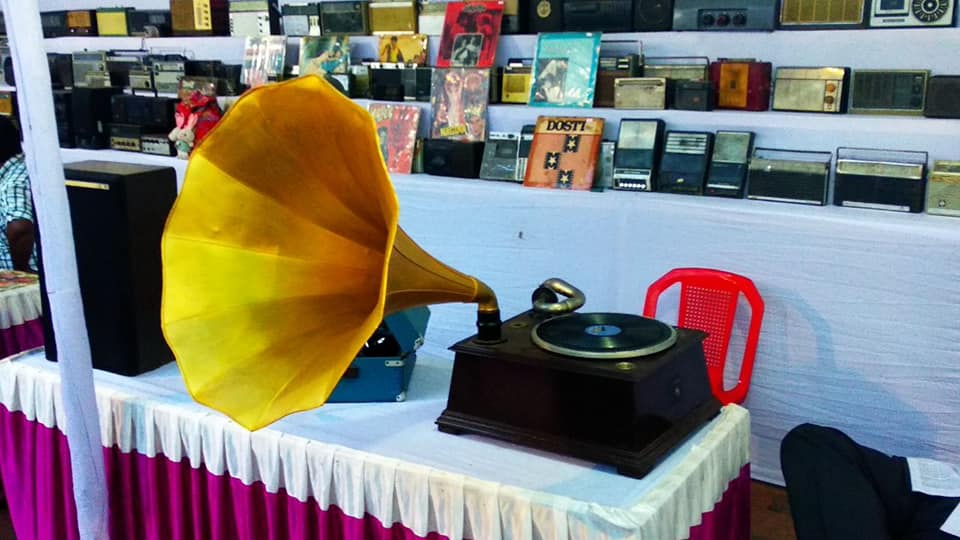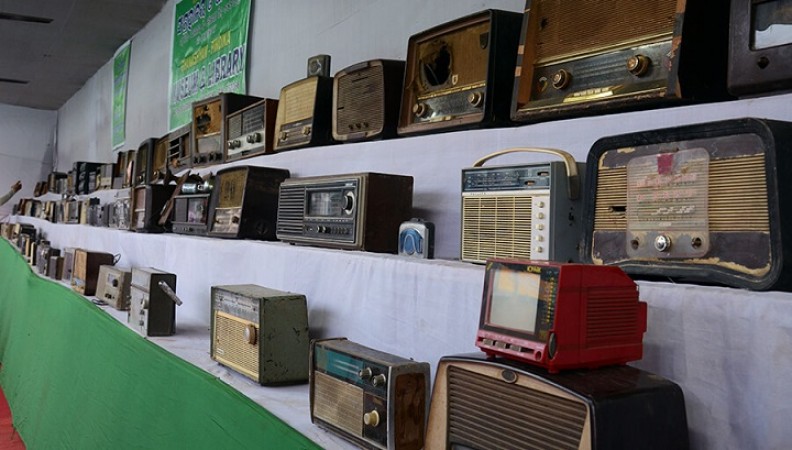History of Radio Broadcast in India

Radio & its Relevance
November 9, 2023
Azadi Ka Amrit Mahotsav Special
November 16, 2023History of Radio Broadcast in India
Dr. Mrinal Chatterjee
The first experimental radio broadcast in India took place in Bombay (now Mumbai) in 1921. More systematic radio broadcasts began in 1923 through radio clubs located in Calcutta (now Kolkata), Bombay and Madras (now Chennai). The Radio Club of Bombay broadcast the first programme in 1923. This was followed by the setting up of a Broadcasting Service that went on air on July 23, 1927 in Bombay under an agreement between the Government of India and a private company named The Indian Broadcasting Company Ltd. It marked the beginning of organised broadcasting in India. Calcutta began its service five weeks later.
The first ever news bulletin in the country went on air from the Bombay Station on July 23, 1927. A month later on August 26, 1927 a news bulletin in Bengali was started from the Calcutta Station. Until 1935, two bulletins, one each in English and Hindustani were broadcast from Bombay and a bulletin in Bengali and English was broadcast from Calcutta.
The Indian Broadcasting Company went into liquidation in March, 1930 following which broadcasting came under the direct control of the Government of India. It was Sir John Reith, founder and the first Director General of British Broadcasting Corporation (BBC), who persuaded the Government to have a national broadcasting service for India. The Government appointed a BBC producer Lionel Fielden as the chief architect and controller of what was initially named the Indian State Broadcasting Service under the department of ‘Controller of Broadcasts’. It was renamed All India Radio on June 8, 1936. (It also came to be known as Akashvani in 1956)
The breakthrough in news broadcasting came after January 1936 when the first news bulletin from the Delhi Station went on air on January 19, 1936 coinciding with the start of its transmission. Besides, news bulletins in English and Hindustani, talk shows on current affairs were also started in both the languages.
The Central News Organization was set up on August 1, 1937. Mr. Charles Barns took charge as the first News Editor in September and he later became the first Director of News. The outbreak of the Second World War in 1939 gave an impetus to the development of the organization. The Monitoring Service was set up in 1939 to monitor foreign broadcasts. In 1943, the External Broadcast Unit was set up under the Director of News. By 1945, the Central News Organization was broadcasting news bulletins in different Indian languages as well as in the External Services. After Independence, news broadcasts of AIR grew both in quantity and quality. More emphasis was laid on national and regional news bulletins.
When India attained Independence in 1947, and the country was divided, the assets of AIR were divided between India and Pakistan in a 2:1 ratio. After division, AIR had a network of six stations and a complement of 18 transmitters. The coverage was 2.5 per cent of the area and just 11 per cent of the population. Rapid expansion of the network took place after independence. A pilot project was drawn up in 1947 for the development of broadcasting across the country. The advent of cheap transistor radio sets by late 1960s contributed to popularizing the medium.
By March 31, 2012 Akashvani network consisting of 277 stations and 432 broadcast transmitters (148 are MW (Medium Wave), 236 FM (Frequency Modulation) and 48 SW (Short Wave) transmitters provided coverage to 99% of the population spread over the country. AIR originated programming in 23 languages and 146 dialects . In External services, it covered 27 languages; 17 national and 10 foreign languages.
AIR started the first FM service in 1977 and then gradually increased the network with its channels viz. AIR FM Gold, AIR FM Rainbow, etc. By mid 2013 number of stations increased to 376 and transmitters to 546.
All India Radio, now under Prasar Bharati, has the distinction of being one of the major broadcasting organizations in the world. The News Services Division (NSD) of All India Radio disseminates news and comments to listeners in India and abroad. From 27 news bulletins in 1939-40, AIR by early 2013 broadcasts over 647 news bulletins both in the home and in external services. This included news bulletins mounted exclusively on FM Gold channel from 22 AIR Stations. In addition to the daily news bulletins, the News Services Division also aired everyday a number of news-based programmes on topical subjects from Delhi and some other Regional News Units. The External Services Division of All India Radio broadcasts in 27 languages – 16 foreign and 11 Indian languages. These services are radiated for an aggregate duration of 72 hours daily and are projected to over 100 countries.
Vividh Bharati, the entertainment arm of AIR (earlier known as All India Variety Programme (AIVP)) was launched on October 3, 1957 in response to the popularity of Radio Ceylon , which is presently known as Sri Lanka Broadcasting Corporation. Radio Ceylon is the oldest radio station in Asia. It was started on an experimental basis in Ceylon by the Telegraph Department in 1923, just three years after the inauguration of broadcasting in Europe. It started an entertainment focused Hindi service in the early 1950s, which became very popular. The station employed some of the most popular Indian announcers who played a vital role in establishing Radio Ceylon as the ‘King of the Airwaves’ in South Asia. Among them were Gopal Sharma, Vijay Kishore Dubey, Shiv Kumar Saroj, and Manohar Mahajan. Sunil Dutt (who went on to become a film star in Bollywood and then joined politics and became a minister), Ameen Sayani and his elder brother Hamid Sayani though not hired by Radio Ceylon became popular by using Radio Ceylon for broadcasting programs like ‘Binaca Geetmala’ (first broadcast in 1952) and ‘Lipton Ke Sitaare’. What captured the Indian listener were the film songs. The 1950s-1960s was the golden age of Hindi film music. Radio Ceylon was at the right place at the right time to reach out to a target market of millions of listeners. Radio Ceylon began to lose its hold over the audience in India after Vividh Bharti was launched.
Prasar Bharti, an autonomous Broadcasting corporation was set up on November 23, 1997 to handle the activities of Akashvani and Doordarshan .
In India, All India Radio – the public service broadcaster, had monopoly on Radio Broadcast, till 2000. In May 2000, the Government of India opened the sector for participation by the private FM broadcasters and offered 108 frequencies in 40 cities for open tender bidding.
FM Radio was first introduced by All India Radio in 1972 at Madras and later in 1992 at Jalandhar. The first private FM station in India was Radio City, which started functioning in Bangalore in 2001. Although listenership grew, but the policies made private radio stations financially unviable. However, the situation improved and by end 2009, a total of 248 private FM stations and 171 FM transmitters of AIR stations were operational in the country. Majority of private commercial radio stations were backed by media houses with interest in media activities like TV or print. The third phase of the FM Radio expansion envisages setting up of another around 800 FM stations, taking the total number of such radio stations to over 1,000. The Cabinet on May 1, 2013 approved the decision to e-auction 839 FM radio channels in 294 cities which have a population of over 100,000. An early 2013 CII-Ernst & Young report said that the FM radio segment was expected to grow by Rs 2,300 crore at a compounded annual growth rate of 18% within three years after Phase-III.
Another long standing issue for private FM radio stations related to airing of news. Private FM stations have not been permitted to air news. However, the new policy is also expected to include permission to private FM stations to broadcast news content, though only those sourced from Doordarshan and All India Radio.
Community Radio Stations (CSR) grew in India from mid 1990s. Community radio is a radio service offering a third model of radio broadcasting in addition to commercial and public broadcasting. It caters to the interests of a certain area, broadcasting content that is popular to a local audience but which may often be overlooked by commercial or mass-media broadcasters. It has three distinct characteristics. Firstly, it is characterised by the active participation of the community in the process of creating news, information, entertainment and culturally relevant material, with an emphasis on local issues and concerns. With training, local producers can create programmes using local voices. The community can also actively participate in the management of the station and have a say in the scheduling and content of the programmes. Secondly, it is essentially a non-profit enterprise. In these days of highly commercialised broadcasting, the ethos of community radio remains independence and a responsibility to serve the community, not the advertiser. As the station is owned by the community, it also maintains some responsibility in the running of the station. And, thirdly, community radio programming is designed by the community, to improve social conditions and the quality of its cultural life. The community itself decides what its priorities and needs are in terms of information provision.
In India the campaign to legitimise community radio began in the mid-1990s, soon after the Supreme Court of India ruled in its judgment of February 1995 that “airwaves are public property.” This inspired groups across the country; however, only educational (campus) radio stations were originally permitted (under a number of conditions).
Anna FM was India’s first campus “community” radio station. Launched on 1 February 2004, it is run by the Education and Multimedia Research Centre (EM²RC); all programmes are produced by Media Science students at Anna University.
On 16 November 2006, the government of India implemented new Community Radio Guidelines, which permitted NGOs and Civil Society Organizations to own and operate community radio stations. The first community-based radio station ‘Sangham Radio’ in Pastapur village, Medak district, Andhra Pradesh, licensed to an NGO (as distinct from campus-based radio) was launched on October 15, 2008. According to the Ministry of Information & Broadcasting, 47 community radio stations (CRS) were operational in India by November 1, 2009, including 45 campus-based stations and two run by NGOs. By 1 July 2010, 68 community radio stations were on the air. By early 2016, the number has grown to about 200.
Radio in Odisha
The first radio station in Odisha was set up at Cuttack in 1948, the year Cuttack High Court was founded and foundation stone for the new capital of Odisha was laid in Bhubaneswar. All India Radio, Cuttack started functioning from January 28, 1948 with a 1-kilowatt Medium Wave transmitter. It was one of the first groups of stations started after independence. H.R.Luthra was the first Station Director of AIR, Cuttack.
It started its Vividh Bharti operation in 1962 and commercial broadcasting service in 1975. An auxiliary studio of AIR equipped with multipurpose studio and recording cum control room was set up in Bhubaneswar on January 27, 1976 ‘to facilitate recording of state ministers and other dignitaries at the state capital’.
By early 2016, there were 13 AIR stations in Odisha and 23 transmitters (8 Medium Wave, 1 Short Wave and 14 Frequency Modulated). Among the 13 radio stations located in Odisha, Cuttack, Sambalpur (established on May 26, 1963), Jeypore (June 28, 1964), and Bhawanipatna (December 30, 1993) were Regional Stations. Rourkela (June 24, 1985), Keonjhar (November 29, 1988), Baripada (February 25, 1991), Bolangir, Joranda (October 3, 1995), Puri (January 26, 1999) and Berhampur (August 15, 1999; it was the 150th Station of AIR). There were three private commercial radio stations operating in Odisha: Radio Choklate, Red FM and Big FM and six Community Radio Stations in Odisha, highest among the Eastern India states. By early 2023, Odisha presently has thirteen AIR stations, four private owned commercial radio stations and twenty three community and campus radio stations. In the last one decade, there have been several radio stations on Internet beginning with odiaradio. By early 2023 there are many including Radio Bhubaneswar, Radio Jajabara, Just Odisha Radio, Sundargarh based Radio Deewana, and many others.
*
Journalist turned media academician Mrinal Chatterjee works as Professor and Regional Director at Indian Institute of Mass Communication (IIMC), Dhenkanal, Odisha.
Sanchar Marg, Dhenkanal 759 001, Odisha
mrinalchatterjeeiimc@gmail.com




